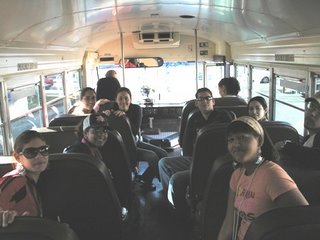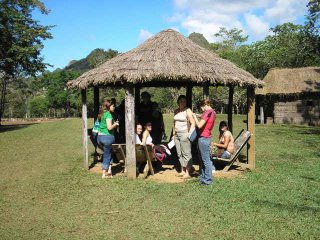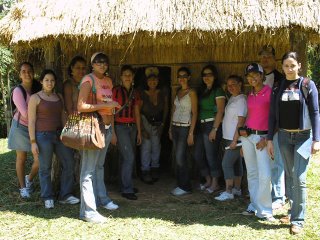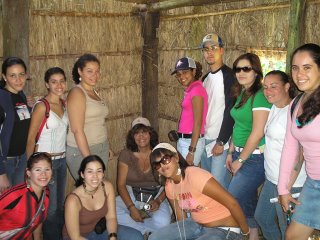The Caguana Ceremonial Ball Courts Site dates from Puerto Rico's late prehistoric and early contact era. The Taino Indians constructed the stone-lined ball courts, called bateyes, between 1200 and 1500 AD, and they used the site throughout the Spanish contact period.
<><>
The first written description of the game, played with two teams and a rubber ball, appeared after Columbus' first voyage. More than just a sport, the game had ceremonial significance, for the game's outcome influenced important Taino decisions. It is believed that the game of batey originated in Mesoamerica, and that it reached its most complex expresion in Puerto Rico. The Caguana site, the largest site of its type in the West Indies, is located in the rainy west central mountains on the east side of the Tanama River, in Barrio Caguana, Utuado.
<>
These plazas are characterized by rows of upright stones embedded in the ground to delimit the area. In Puerto Rico, the most important of these sites is the Caguana Ceremonial Center. The Caguana Site is a large ceremonial center constructed during the late prehistoric and early protohistoric Capa Phase (A.D.1200-1500), and occupied by the Tahino indians up through contact with the Spaniards. The site consist of 10 earth and stone line ball courts, making this the largest of its kind in the entire West Indies.
<>
In essence, The Caguana Site, as a ball court and ceremonial center had different functions: First, it was used for ceremonial dances, religious rituals and other rites; second, it was used for playing ball games in which two teams of equal in numbers tossed a ball to each other; and third, we believe it was used to make astronomical observations . The aim of the present study is to determine if there is any relationship between the aligment of the ball courts in Caguana with the sunrise during the solstices and equinoxes. Results indicate that two row of slabs on Plaza A are aligned toward the Autumn and Spring Sunrise. Also, the two shorter sides of Plaza B are aligned toward the Summer Solstice Sunrise. In addition to the Summer Solstice and Equinox Sunrise, the Tahino Indians could also observed the Full Moonrise along Plaza A.
In essence, The Caguana Site, as a ball court and ceremonial center had different functions: First, it was used for ceremonial dances, religious rituals and other rites; second, it was used for playing ball games in which two teams of equal in numbers tossed a ball to each other; and third, we believe it was used to make astronomical observations . The aim of the present study is to determine if there is any relationship between the aligment of the ball courts in Caguana with the sunrise during the solstices and equinoxes. Results indicate that two row of slabs on Plaza A are aligned toward the Autumn and Spring Sunrise. Also, the two shorter sides of Plaza B are aligned toward the Summer Solstice Sunrise. In addition to the Summer Solstice and Equinox Sunrise, the Tahino Indians could also observed the Full Moonrise along Plaza A.
<>
_____________________________________
<>
LINKS
<>
<>
 En camino al Santuario Taino de Caguana
En camino al Santuario Taino de Caguana Estudiantes UPR-Rio Piedras
On our way to Caguana

Valle de Manati - Manati Valley
 Subiendo las Montañas - Climbing the Mountains
Subiendo las Montañas - Climbing the Mountains


Caguana 
Entrando al caney - Entering the caney

Santuario (cu) Sagrado Taino - Sacred Taino Sanctuary

 Estudiantes frente a la Plaza (Batey) Principal -Main Batey
Estudiantes frente a la Plaza (Batey) Principal -Main Batey
 Petroglifo de Atabey - la Mujer de Caguana - Atabey Petroglyph
Petroglifo de Atabey - la Mujer de Caguana - Atabey Petroglyph
 El Batey Rectangular - Rectangular Plaza
El Batey Rectangular - Rectangular PlazaSitios que tratan el tema de Caguana
Sites with information about Caguana
http://www.indio.net/taino/research/caguana.htm
http://prboriken.com/caguana.htm
http://www.indio.net/taino/research/acaguana.htm
http://graduados.uprrp.edu/inventio/vol2/caguana.htm
http://uctp.blogspot.com/2005/08/relevant-information-on-caguana.html
http://www.presenciataina.tv/elba.html


